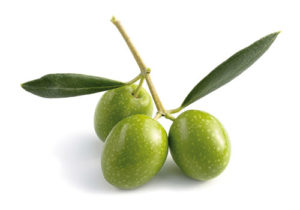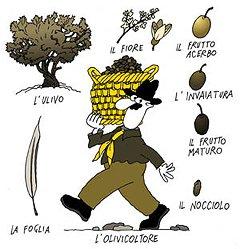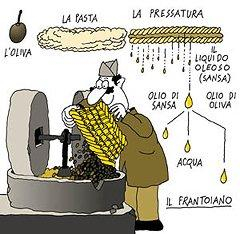 Extra Virgin olive oil is a superior category of olive oil obtained directly from olives and only using mechanical methods. This olive oil has been obtained directly from olives, in conditions that don’t change the properties of the virgin oil, and that has only undergone washing, decanting, centrifuging and filtering. Extra Virgin olive oil has an acidity, expressed as oleic acid, of up to 0.8 grams per 100 grams and having the other characteristics required for this category of olive oil.*
Extra Virgin olive oil is a superior category of olive oil obtained directly from olives and only using mechanical methods. This olive oil has been obtained directly from olives, in conditions that don’t change the properties of the virgin oil, and that has only undergone washing, decanting, centrifuging and filtering. Extra Virgin olive oil has an acidity, expressed as oleic acid, of up to 0.8 grams per 100 grams and having the other characteristics required for this category of olive oil.*
*Source: EC Regulation 1019/02
The quality of extra virgin olive oil
The parameters and factors that influence the quality of extra virgin olive oil are:
- Harvesting and ripeness of the olives;
- Timing and storage methods of the olives;
- How the oil is extracted;
- Olive oil conservation.
Harvesting and ripeness of the olives
In Italy, olives are traditionally harvested from mid-October to the end of December, though the ideal period varies from region to region depending on the particular climate of the geographical area and the different cultivars.
Harvesting is a critical step in obtaining the desired quality of olive oil, and there are several methods which vary depending both on the type of olive tree and the geographical conditions of the terrain.
 In some regions, harvesting is still done by hand using rakes (picking) with nets on the ground; in other regions people beat the branches of the plant with flexible sticks to cause the olives to fall from the tree. In other regions people still wait until the olives are perfectly ripe and fall onto the ground on their own (in this latter case, the olive oil is low quality).
In some regions, harvesting is still done by hand using rakes (picking) with nets on the ground; in other regions people beat the branches of the plant with flexible sticks to cause the olives to fall from the tree. In other regions people still wait until the olives are perfectly ripe and fall onto the ground on their own (in this latter case, the olive oil is low quality).
Lastly, there is a modern technique that involves the use of mechanical rakes (or vibrating devices) to shake the branches of the tree and cause the olives to fall onto nets arranged directly around the machine, thus allowing people to collect them faster.
The olives are harvested when they are just at the right ripeness and are then taken to the olive oil mill where they are stored for a maximum of 24 hours. In order to obtain extra virgin olive oil without any defects, the storage process is very important. The best way is to store the olives is in perforated plastic bins kept in cool and well-ventilated places, away from water and from unpleasant smells. The olives must be pressed within a maximum of 24-48 hours from harvesting to prevent anaerobic fermentation processes starting, which cause defects in the oil such as heating and, in extreme cases, mould.
Extracting the extra virgin olive oil from olives
Before pressing, the leaves and twigs must be removed from the olives. The olives are then washed to remove any contaminants.
The olive fruit is made up of about 20-25% olive oil, 35-50% water (vegetation water) and the remaining is a paste called pomace.
 In order to be marketed as “Extra Virgin” the olive oil must be obtained only using mechanical methods. Indeed, extra virgin olive oil is extracted from olives only using mechanical methods, and this is what distinguishes extra virgin olive oil from other olive oils obtained using other methods that are based on physical and chemical processes (e.g. refined olive oils, olive-pomace oils).
In order to be marketed as “Extra Virgin” the olive oil must be obtained only using mechanical methods. Indeed, extra virgin olive oil is extracted from olives only using mechanical methods, and this is what distinguishes extra virgin olive oil from other olive oils obtained using other methods that are based on physical and chemical processes (e.g. refined olive oils, olive-pomace oils).
Olive oil extraction processes start with pressing, i.e. the crushing of the olive drupes, followed by other steps to extract the oil from the olives. In general, there are three extraction methods:
- Discontinuous or traditional method: in this method, the olives are pressed using millstones, thus the olives are crushed by mechanical pressure. The paste obtained by pressing the olives is then kneaded to favour the aggregation of the oil micelles. The paste is then spread on special strainers, particular nylon filter discs for food, with steel discs placed between every 4 or 5. The stacks are then placed in special hydraulic presses and are pressed at a pressure of ca. 350/400 atm to separate the oil and vegetation water from the paste (pomace). The extra virgin olive oil is finally separated from the vegetation water by centrifugation.
- Continuous method: the olives are pressed using modern crashing machines with hammers (or with knives) that crush the olives on a perforated cylinder. The paste obtained by pressing the olives is then kneaded to favour the aggregation of the oil micelles. Subsequently the paste undergoes horizontal centrifugation using a decanter; the high rotation speed causes the olive oil to separate from the vegetation water and pomace, or only the vegetation water from the pomace. In the latter case, it is necessary to carry out another separation through vertical centrifugation to separate the olive oil from the vegetation water.
- Semi-continuous: the olives are pressed using millstones and then the olive oil is extracted from the paste by centrifugation in the decanter, like for the continuous method.
In general, the amount of oil extracted, as a percentage, from olives can vary enormously and is generally between a minimum of 8/9 kg of extra virgin olive oil per 100 kg of pressed olives up to a maximum of 22/28 kg of extra virgin olive oil per 100 kilograms of pressed olives. The variation is caused by factors such as different cultivars, when harvesting occurs, exposure of olive trees to the sun, the water availability during the year and when the olives are growing.
Olive oil conservation
Extra virgin olive oil should be stored at between 14 and 18 degrees centigrade, in a dry place, away from light, air, heat and unpleasant smells since these factors adversely affect its conservation.
Temperature: The optimal temperature for keeping olive oil is between 14 and 18 degrees centigrade. High temperatures accelerate degradative chemical reactions. At low temperatures, however, the oil tends to freeze and solidify.
Oxygen: Contact with the air causes the oil to oxidise and this alters the chemical composition and changes the colour, smell and flavour of the oil.
Light: Ideally, olive oil should be stored in dark containers because light can alter both its colour and flavour. For this reason, it is preferable to use dark glass bottles. Indeed, dark glass reduces the penetration of light through the bottle, allowing the oil to last longer. One excellent method is to put the oil into stainless steel containers with a tightly closed lid.

